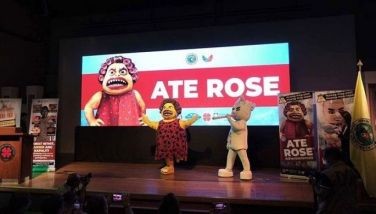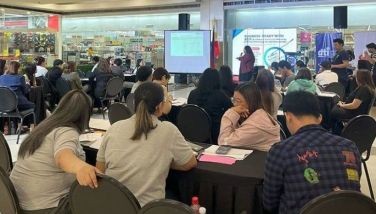Exit beloved buffoon - WHY AND WHY NOT by Nelson A. Navarro
October 9, 2000 | 12:00am
President Estrada is not alone. He’s not the first and certainly won’t be the last Filipino President to be savaged by the foreign media. As he reels from each and every cruel salvo hurled by such influential publications as the New York Times, Washington Post, Wall Street Journal, Times of London, Time, Newsweek and others, all he has to remember is that all his predecessors from Manuel Luis Quezon to Fidel Valdez Ramos have done their own time in the trenches of media disapproval and ridicule. Here, we’re not even counting the sizzling immediacy of protests and insults routinely dispensed by satellite television and radio on a 24-hour basis.
Call it an occupational hazard of the Philippine presidency or the leadership of any country for that matter. In this age of instant global communications, no head of state or monarch can be considered safe from media bombardment. Whether they do right or wrong, they’re nonetheless subject to the prissiest of standards and expectations. Only within national boundaries are the most incorrigible despots arguably safe from the claws of foreign correspondents and critics.
Still, it’s only a matter of time before even the most hermetically sealed society can consider itself immune from harangues and exposés snipped out of offending papers or scrambled off the air.
The sting of foreign criticism is particularly painful because there’s nothing the object of attack can do about it. None apart from banning journalists and harassing their local contacts. Libel charges may be filed as Indonesia’s Suharto has done with Time or Pakistan’s Benazir Bhutto with her British media tormentors. But in the end, it’s only in the court of public opinion where the fight is really won or lost – and it is a most fickle and exasperating court, fairly or unfairly loaded against authoritarian figures.
Media pet peeves like Britain’s Margaret Thatcher have, of course, tried to fight back. She was partly lucky because her belligerent conservatism happened to be the flavor of the British masses. But when the political tide swung back to labor and liberalism years later, she was as good as dead.
President Estrada is one example of a leader who initially managed to dodge the foreign media hate-list and to be briefly ballyhoed as some kind of a lovable buffoon with the common touch, only to be dragged down the mire as the most uncouth of petty tyrants.
How Estrada could have botched his one golden opportunity to craft an enduring positive media image looms as a textbook case in amateurish political career development.
It’s been said that the original and present handlers of Estrada were pragmatic operators like the Zamora brothers who are lawyers and bankers and Reli German, an advertising man. Manny and Ronnie Zamora quickly saw the political potentials of the aging movie star they helped become mayor of their small suburban town of San Juan. German, Estrada’s closest high school classmate (until that infamous Bunny scam), was always there to polish the crude but infectious humor that came to be Estrada’s trademark.
Somewhere along the line, in 1987, the post-Marcos hiatus that had consigned Estrada to seeming oblivion offered another political opening too tempting to be missed. The newly installed Cory government, already showing cracks, had called for elections and the marginalized Marcos crowd needed a lot of sacrificial lambs and some plausible winners.
Estrada and Johnny Ponce Enrile turned out to be the only survivors of the Cory tsunami in the Senate. From the day he stepped into the august body most commentators said he was totally unfit for, Estrada was ironically marked as presidential material of sorts.
At first, the very idea seemed ridiculous. Then Senator Ernie Maceda, one of the shrewdest politician ever produced by this country, claims he spotted Estrada’s potentials right from the beginning. As far as Maceda was concerned, the failure of the Edsa movement to live up to euphoric promises of reform had turned politics into a cynical popularity game. The way to power seemed measurable in terms of name and face recall or market tests once deemed relevant only to the promotion of consumer items like soap and shampoo. Or of Tagalog movies of which Estrada was an established star.
Estrada was so popular that in the next 1992 elections he was an early favorite as president. Although he had to quit because the big boys had more money and the taipans had other candidates in mind, Estrada settled for vice president and won. In no time at all, the very same taipans who snubbed him poured billions of pesos into the next campaign. The further disarray of the Edsa coalition and above all President Ramos’ fatal choice of Joe de Venecia all but ceded the 1998 elections to Estrada.
Even Time magazine wanted to give the new president the benefit of the doubt. The honeymoon was, however, cut short by Estrada’s inexplicable decision to bury the long-unburied Ferdinand Marcos in the National Heroes Cemetery. Perhaps it was hubris or the intoxicating ego boost he derived from his electoral sweep. But it fanned old and terrible fears which, in turn, led to more of Estrada’s chronic miscalculations of the people’s will.
Nelson A. Navarro’s e-mail address:<noslen11@yahoo.com>
Call it an occupational hazard of the Philippine presidency or the leadership of any country for that matter. In this age of instant global communications, no head of state or monarch can be considered safe from media bombardment. Whether they do right or wrong, they’re nonetheless subject to the prissiest of standards and expectations. Only within national boundaries are the most incorrigible despots arguably safe from the claws of foreign correspondents and critics.
Still, it’s only a matter of time before even the most hermetically sealed society can consider itself immune from harangues and exposés snipped out of offending papers or scrambled off the air.
The sting of foreign criticism is particularly painful because there’s nothing the object of attack can do about it. None apart from banning journalists and harassing their local contacts. Libel charges may be filed as Indonesia’s Suharto has done with Time or Pakistan’s Benazir Bhutto with her British media tormentors. But in the end, it’s only in the court of public opinion where the fight is really won or lost – and it is a most fickle and exasperating court, fairly or unfairly loaded against authoritarian figures.
Media pet peeves like Britain’s Margaret Thatcher have, of course, tried to fight back. She was partly lucky because her belligerent conservatism happened to be the flavor of the British masses. But when the political tide swung back to labor and liberalism years later, she was as good as dead.
President Estrada is one example of a leader who initially managed to dodge the foreign media hate-list and to be briefly ballyhoed as some kind of a lovable buffoon with the common touch, only to be dragged down the mire as the most uncouth of petty tyrants.
How Estrada could have botched his one golden opportunity to craft an enduring positive media image looms as a textbook case in amateurish political career development.
It’s been said that the original and present handlers of Estrada were pragmatic operators like the Zamora brothers who are lawyers and bankers and Reli German, an advertising man. Manny and Ronnie Zamora quickly saw the political potentials of the aging movie star they helped become mayor of their small suburban town of San Juan. German, Estrada’s closest high school classmate (until that infamous Bunny scam), was always there to polish the crude but infectious humor that came to be Estrada’s trademark.
Somewhere along the line, in 1987, the post-Marcos hiatus that had consigned Estrada to seeming oblivion offered another political opening too tempting to be missed. The newly installed Cory government, already showing cracks, had called for elections and the marginalized Marcos crowd needed a lot of sacrificial lambs and some plausible winners.
Estrada and Johnny Ponce Enrile turned out to be the only survivors of the Cory tsunami in the Senate. From the day he stepped into the august body most commentators said he was totally unfit for, Estrada was ironically marked as presidential material of sorts.
At first, the very idea seemed ridiculous. Then Senator Ernie Maceda, one of the shrewdest politician ever produced by this country, claims he spotted Estrada’s potentials right from the beginning. As far as Maceda was concerned, the failure of the Edsa movement to live up to euphoric promises of reform had turned politics into a cynical popularity game. The way to power seemed measurable in terms of name and face recall or market tests once deemed relevant only to the promotion of consumer items like soap and shampoo. Or of Tagalog movies of which Estrada was an established star.
Estrada was so popular that in the next 1992 elections he was an early favorite as president. Although he had to quit because the big boys had more money and the taipans had other candidates in mind, Estrada settled for vice president and won. In no time at all, the very same taipans who snubbed him poured billions of pesos into the next campaign. The further disarray of the Edsa coalition and above all President Ramos’ fatal choice of Joe de Venecia all but ceded the 1998 elections to Estrada.
Even Time magazine wanted to give the new president the benefit of the doubt. The honeymoon was, however, cut short by Estrada’s inexplicable decision to bury the long-unburied Ferdinand Marcos in the National Heroes Cemetery. Perhaps it was hubris or the intoxicating ego boost he derived from his electoral sweep. But it fanned old and terrible fears which, in turn, led to more of Estrada’s chronic miscalculations of the people’s will.
BrandSpace Articles
<
>
- Latest
- Trending
Trending
Latest

























